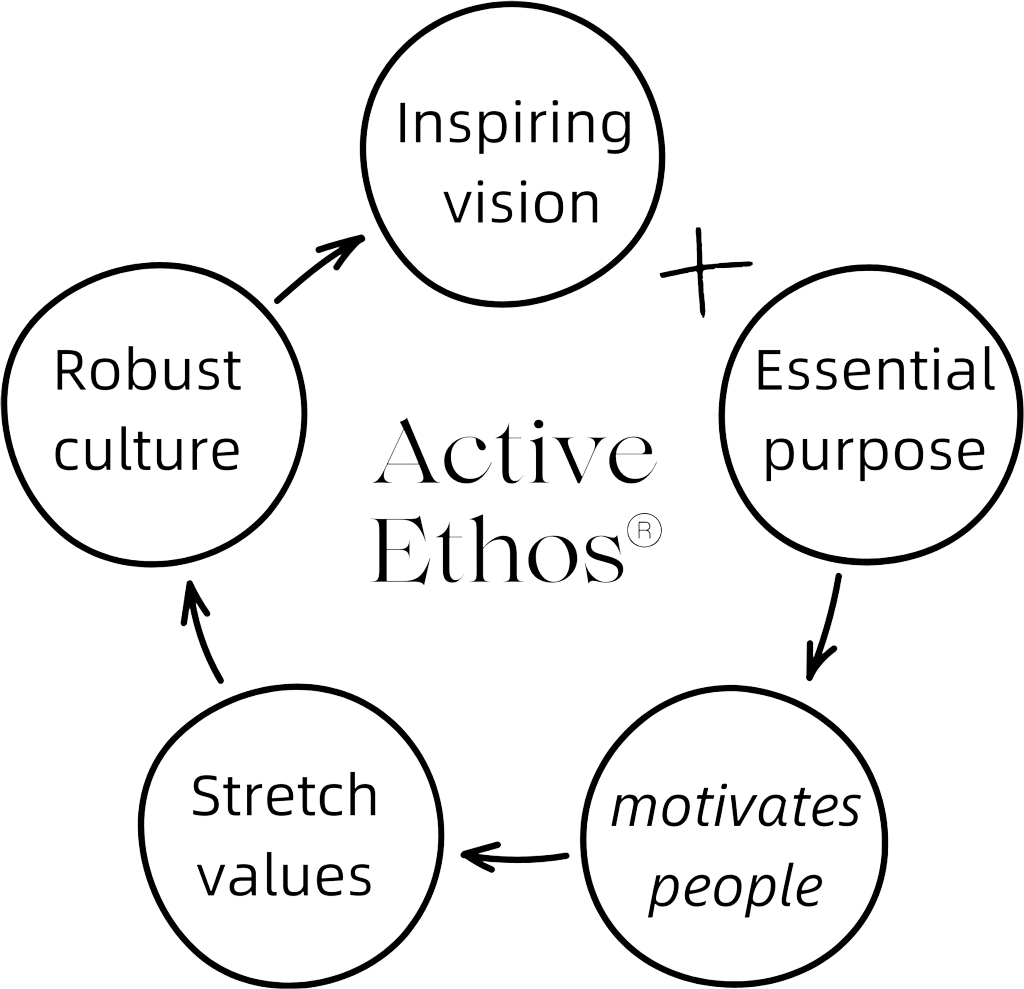Active Ethos


The Active Ethos® process is designed to embed a company’s values and purpose into every aspect of its culture and operations.
Who needs it? Any organisation undergoing change, be that growth or reduction in size, takeover or taking over, new locations opening or old ones closing, change of leadership, outside influences – you name it. These are the moments at which we tend to realise that at least one of our vision, purpose, values and culture isn’t up to the job, and that we may well need help to untangle things.
It takes place in-house, with a committed, consultative and embedded approach. Using the Circles of Context model, Active Ethos® begins with a thorough understanding of what is within an organisation’s control, what is influenced by it, and external factors that impact its operations.



Context analysis to unearth the influences you might not see at first glance

Brings values to life through defined roles and measurable actions

Articulating clear vision, purpose, and value



Planning activities with timetables and KPIs

Creating a champions network.
What does it mean?
Pretty circle, huh? So what does it mean?
The starting point is Purpose and Vision. This is the combined spark that sets everything else in motion.
A great purpose is an incontestable purpose. It speaks for itself. It is obvious, useful and true. The purpose of a hammer is to hammer in nails, and your organisation’s purpose must be that clear. It is the reason people commit their time and energy, and the difference your organisation makes in the world.
Your vision is an opportunity to really light some flames. It should stir something in people. As leaders, we are surrounded by numbers. Revenue, margins, percentages, headcount, SKUs. And while those metrics matter, they are rarely what motivates your people. To lead effectively, you need to understand their motivation: what they care about, what progress means, how they want to experience their working lives. Your vision needs to be the vision you have shaped, expressed with insight into your people and their motivation, so it lands with meaning.
I cannot say often enough that this is not an abdication of leadership. It is an effortful focus on understanding what matters to the people you want to attract and retain, in whatever capacity. When you speak in words that feel familiar and true, you create alignment. You show that you know them and from that place of trust, people can thrive.
And values. Oh, how I love values. I know no other personal or business asset that can underpin such bravery, such growth, such understanding, such connection. These are the principles that reflect who you are at your best. Not generic aspirations but clear, tested truths that guide behaviours and support people to achieve the vision.
When chosen with care and applied consistently, values become the backbone of decision-making. They create a shared understanding of what good looks like and why it matters. They fuel successful collaborative endeavour.
And why do people care enough to make the effort? Because they know what they are working towards and they believe it is worth it.
It is important to recognise that these three elements behave differently in real life. Vision is often an internal focus, helping to shape decisions, strategies and direction. Purpose and values, on the other hand, will do their work internally and externally. They are evident in how you operate as a business, how people are treated, your client and supplier relationships, and how trust is built. When all three are clear and aligned, they reinforce one another and create the conditions for culture to thrive.
This focus on applied values – through everyone, everywhere, in everything they do – shapes your culture. Culture is not a fixed asset. It is a living, evolving pattern of behaviours, habits and norms. You see it in how people speak to one another, how problems are solved and how reputation is built. It is external as much as internal. It is your most powerful public-facing asset or your greatest liability. That is why consistency matters. This is how you earn trust and how you keep it.
A strong, aligned culture enables excellent performance. Not only in terms of outcomes but in the quality of thinking, efficiency and resilience that support those outcomes. It strengthens brand reputation. It attracts and retains talent. It helps to build lasting partnerships and trusted client relationships. It reinforces your standards and brings clarity to your work.
These four elements form a living system. Purpose and vision spark momentum. Values guide actions. Culture grows through everyday behaviours. Consistent performance confirms and strengthens the whole. Over time, this becomes a flywheel, or even a steady upward spiral of consistency and impact.
But what do your values achieve? When they are properly rooted in truth, they become a filter. You attract the right people and organisations. Not just team members, but clients, collaborators and partners who share your standards and outlook. You do not waste time with the wrong fit. It makes working together simpler, more open and far more effective.
Values are how we build and sustain trust. Trust in yourself, to make decisions well. Trust from others, earned through consistency and care.
Values are how we hold power – not wielding it with impunity, but escorting it with integrity. Administered wisely, power allows us to protect, include and raise. Sadly we are surrounded by growing evidence of what happens when power is misused.
So, as trust in institutions, leaders and businesses erodes, it feels like the right time to focus on these things ourselves, and restore a bit of balance in the world.
Ambition
Inspired team, aiming high
Purpose
Renewed sense of purpose
Bravery
Appetite for opportunity and calculated risk
Impact
Strengthened market impact
Investment
Attractiveness to investors
Retention
Focused talent loyal to the organisation
Sales
Magnetic draw to customers
Loyalty
Increased loyalty in existing customers
Brand
Raised brand awareness and passion
Honesty
Atmosphere of honesty, of holding colleagues and self to account
Profitability
Maximised profitability through focus, efficiency and sense of ownership
Peer approval
Exemplar status in sector



